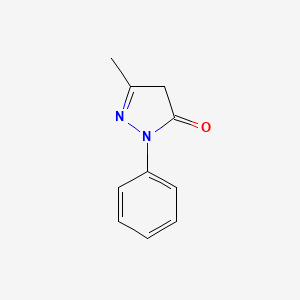D0340 | Edaravone
N
N07XX14 Edaravone
[N07XX] Other nervous system drugs
[N07X] OTHER NERVOUS SYSTEM DRUGS
[N07] OTHER NERVOUS SYSTEM DRUGS
[N] Nervous system
| Toxicity | Dose | Time | Species | Model | Method | Action | Positive criterion | Reference |
|---|---|---|---|---|---|---|---|---|
| MEMBRANE POTENTIAL | 31.75±4.28 | human | qHTS-HepG2 | MMP assay | decrease | IC50 | 163 | |
| MEMBRANE POTENTIAL | 28.18 | human | HepG2 | MMP assay | decrease | IC50 | 163 | |
| MEMBRANE POTENTIAL | 25.79±10.10 | rat | hepatocytes | MMP assay | decrease | IC50 | 163 | |
| Pictogram | Signal | Statements | Precautionary Statement Codes |
|---|---|---|---|
 |
Warning |
Aggregated GHS information provided by 216 companies from 23 notifications to the ECHA C&L Inventory. Each notification may be associated with multiple companies. Reported as not meeting GHS hazard criteria by 15 of 216 companies. For more detailed information, please visit ECHA C&L website Of the 21 notification(s) provided by 201 of 216 companies with hazard statement code(s): H302 (26.87%): Harmful if swallowed [Warning Acute toxicity, oral] H315 (50.25%): Causes skin irritation [Warning Skin corrosion/irritation] H317 (66.67%): May cause an allergic skin reaction [Warning Sensitization, Skin] H319 (24.38%): Causes serious eye irritation [Warning Serious eye damage/eye irritation] H335 (27.86%): May cause respiratory irritation [Warning Specific target organ toxicity, single exposure Respiratory tract irritation] H412 (42.79%): Harmful to aquatic life with long lasting effects [Hazardous to the aquatic environment, long-term hazard] H413 (17.41%): May cause long lasting harmful effects to aquatic life [Hazardous to the aquatic environment, long-term hazard] Information may vary between notifications depending on impurities, additives, and other factors. The percentage value in parenthesis indicates the notified classification ratio from companies that provide hazard codes. Only hazard codes with percentage values above 10% are shown. |
P261, P264, P270, P271, P272, P273, P280, P301+P312, P302+P352, P304+P340, P305+P351+P338, P312, P321, P330, P332+P313, P333+P313, P337+P313, P362, P363, P403+P233, P405, and P501; (The corresponding statement to each P-code can be found at the GHS Classification page.) |
 |
Warning |
H317: May cause an allergic skin reaction [Warning Sensitization, Skin] |
P261, P272, P280, P302+P352, P321, P333+P313, P363, and P501; (The corresponding statement to each P-code can be found at the GHS Classification page.) |
| (MCI-186) | 1-Fenyl-3-methyl-2-pyrazolin-5-on | 1-Fenyl-3-methyl-2-pyrazolin-5-on [Czech] |
| 1-PEHNYL-3-METHYL-5-PYRAZALONE | 1-Phenyl-3-methyl-2-pyrazolin-5-on | 1-Phenyl-3-methyl-5-oxo-2-pyrazoline |
| 1-Phenyl-3-methyl-5-pyrazolone | 1-Phenyl-3-methylpyrazolone | 1-Phenyl-3-methylpyrazolone-5 |
| 2 4-Dihydro-5-methyl-2-phenyl-3H-pyrazol-3-one | 2,4-Dihydro-5-methyl-2-phenyl-3H-pyrazol-3-one | 2,4-dihydro-2-phenyl-5-methyl-3H-pyrazol-3-one |
| 2-Pyrazolin-5-one, 3-methyl-1-phenyl- | 3-METHYL-1-PHENYL-2-PYRAZOLIN-5-ONE | 3-METHYL-1-PHENYL-2-PYRAZOLIN-5-ONE (MCI-186) |
| 3-Methyl-1-phenyl-1H-pyrazol-5(4H)-one | 3-Methyl-1-phenyl-2-pyrazolin-5-one, 99% | 3-Methyl-1-phenyl-2-pyrazoline-5-one |
| 3-Methyl-1-phenyl-2-pyrazoline-5-one, 99% | 3-Methyl-1-phenyl-2-pyrazoline-5-one, SAJ special grade | 3-Methyl-1-phenyl-2-pyrazoline-5-one, purum, >=98.0% (NT) |
| 3-Methyl-1-phenylpyrazol-5-one | 3-methyl-1-phenyl-2-pyrazolin-5one | 3-methyl-1-phenyl-4,5-dihydro-1H-pyrazol-5-one |
| 3H-Pyrazol-3-one, 2,4-dihydro-5-methyl-2-phenyl- | 3H-Pyrazol-3-one,4-dihydro-5-methyl-2-phenyl- | 4CA-0486 |
| 4E-901 | 5-Methyl-2-phenyl-2,4-dihydro-3H-pyrazol-3-one | 5-Methyl-2-phenyl-2,4-dihydro-3H-pyrazol-3-one # |
| 5-Methyl-2-phenyl-2,4-dihydro-3H-pyrazol-3-one (Edaravone) | 5-Pyrazolone, 3-methyl-1-phenyl- | 5-methyl-2-phenyl-2,4-dihydro-3-pyrazolone |
| 5-methyl-2-phenyl-2,4-dihydro-pyrazol-3-one | 5-methyl-2-phenyl-2,4-dihydropyrazol-3-one | 89-25-8 |
| AB00375776_14 | AB00375776_15 | AB2000046 |
| AC-4745 | ACT07289 | AE-641/00371017 |
| AI3-03557 | AK128848 | AKOS000313817 |
| AM20060748 | Antipyrine Related Compound A, United States Pharmacopeia (USP) Reference Standard | BBL011741 |
| BCBcMAP01_000127 | BCP26336 | BCP9000635 |
| BCPP000246 | BDBM50200541 | BRD-K35458079-001-04-2 |
| BRD-K35458079-001-12-5 | BRD-K35458079-001-23-2 | BRN 0609575 |
| BSPBio_001235 | BSPBio_002601 | Bio1_000438 |
| Bio1_000927 | Bio1_001416 | Bio2_000448 |
| Bio2_000928 | C.I. Developer 1 | C13008 |
| CAS-89-25-8 | CCG-39352 | CCRIS 512 |
| CDS1_000986 | CHEBI:31530 | CHEMBL290916 |
| CI Developer 1 | CS-1832 | CTK3E8611 |
| D01552 | DB-002517 | DB12243 |
| DSSTox_CID_1130 | DSSTox_GSID_21130 | DSSTox_RID_75961 |
| DTXSID9021130 | Developer Z | DivK1c_001018 |
| DivK1c_002026 | EC 201-891-0 | EINECS 201-891-0 |
| Edaravone (MCI-186) | Edaravone (USAN/JP17/INN) | Edaravone [USAN:INN] |
| F0391-0021 | FT-0608243 | HMS1362M17 |
| HMS1792M17 | HMS1990M17 | HMS2234M19 |
| HMS3266F04 | HMS3403M17 | HMS3411L05 |
| HMS3654L15 | HMS3675L05 | HMS503K17 |
| HMS557M18 | HSDB 4102 | HY-B0099 |
| IDI1_001018 | IDI1_002203 | InChI=1/C10H10N2O/c1-8-7-10(13)12(11-8)9-5-3-2-4-6-9/h2-6H,7H2,1H |
| KBio1_001018 | KBio2_000575 | KBio2_000747 |
| KBio2_003143 | KBio2_003315 | KBio2_005711 |
| KBio2_005883 | KBio3_001029 | KBio3_001030 |
| KBio3_001821 | KBioGR_000575 | KBioGR_001502 |
| KBioSS_000575 | KBioSS_000747 | KS-00000X6I |
| KSC448M1D | LS-1892 | M0687 |
| MCI-186 | MCI-186, Radicut, 89-25-8 | MFCD00003138 |
| MLS000069602 | MLS001146878 | MLS002415675 |
| MLS006011753 | Maybridge1_005738 | Methylphenylpyrazolone |
| Monopyrazolone | NCGC00018218-01 | NCGC00018218-02 |
| NCGC00018218-03 | NCGC00018218-04 | NCGC00018218-05 |
| NCGC00018218-06 | NCGC00018218-07 | NCGC00018218-08 |
| NCGC00018218-10 | NCGC00018218-17 | NCGC00022665-02 |
| NCGC00022665-04 | NCGC00022665-05 | NCGC00022665-06 |
| NCGC00164015-01 | NCGC00256515-01 | NCGC00259296-01 |
| NCI-C03952 | NE10266 | NINDS_001018 |
| NSC 12 | NSC-26139 | NSC-2629 |
| NSC-758622 | NSC26139 | NSC2629 |
| NSC758622 | Norantipyrine | Norphenazone |
| Opera_ID_1057 | Pharmakon1600-01503635 | Phenazone impurity A, European Pharmacopoeia (EP) Reference Standard |
| Phenyl methyl pyrazolone | Phenylmethylpyrazolone | PubChem13301 |
| Q-200386 | Q335099 | QELUYTUMUWHWMC-UHFFFAOYSA-N |
| RTR-028045 | Radicava | Radicava (TN) |
| Radicut | Radicut (TN) | Radicut;MCI-186 |
| SB19128 | SBI-0051836.P002 | SC-13582 |
| SCHEMBL4704 | SMR000059020 | SPBio_001508 |
| SPECTRUM1503635 | SR-01000000135 | SR-01000000135-2 |
| SR-01000000135-3 | SR-01000000135-5 | ST012744 |
| ST2410773 | STK201315 | SW148216-2 |
| Spectrum2_001574 | Spectrum3_000971 | Spectrum4_001091 |
| Spectrum5_001217 | Spectrum_000267 | TR-028045 |
| Tocris-0786 | Tox21_112077 | Tox21_112077_1 |
| Tox21_201747 | Tox21_302819 | WLN: T5NMV DHJ BR& E1 |
| Z50145861 | ZINC18203737 | edaravone |
| s1326 |

